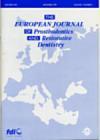European Journal of Prosthodontics and Restorative Dentistry
Recording surface detail on moist surfaces with elastomeric impression materials
Abstract
Abstract - The objective was to assess the ability to accurately record detail on moist surfaces for three elastomeric impression materials derived from different polymers. One polyvinylsiloxane, one polyether and one hybrid material containing a copolymer of siloxane and polyether polymers were used. Impressions were recorded of moist gypsum casts having both a shallow (~ 20 µm) and deep (~ 180 µm) groove reproduced on their surface. The grooves in the casts and in the impressions were proï¬led using a non-contacting laser proï¬lometer. Comparisons were made between the groove depths in the casts and impressions (paired t-test). The results indicated that all of the tested materials accurately recorded dimensions in the x-y plane. However, there was evidence that the polyether and hybrid materials were more accurate than the polyvinylsiloxane in recording the true depths of the deep grooves (z plane) under moist conditions. It was concluded that the more hydrophilic nature of the polyether and hybrid materials enabled them to record more accurate impressions of moist surfaces, particularly in areas of difï¬cult access as modelled by the deep grooves.
KEY WORDS: elastomers, dental impressions, polyvinylsiloxanes, polyethers, detail reproduction
Authors
John F. McCabe, T.E. Carrick
Articles from this issue
 Free Access
Free Access No Access
No Access Full Access
Full Access


